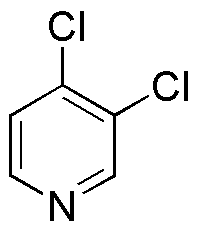3,4-Dichloropyridine is widely utilized in research focused on:
- Agricultural Chemicals: This compound serves as an important intermediate in the synthesis of herbicides and pesticides, helping to enhance crop protection and yield.
- Pharmaceuticals: It is used in the development of various pharmaceutical agents, particularly in the creation of drugs targeting neurological and cardiovascular diseases.
- Material Science: The compound is employed in the production of specialty polymers and resins, offering improved thermal and chemical resistance for industrial applications.
- Analytical Chemistry: It acts as a reagent in analytical methods, aiding in the detection and quantification of other chemical substances in complex mixtures.
- Research and Development: 3,4-Dichloropyridine is utilized in various research projects, particularly in organic synthesis, due to its versatile reactivity and ability to form diverse chemical structures.
General Information
Properties
Safety and Regulations
Applications
3,4-Dichloropyridine is widely utilized in research focused on:
- Agricultural Chemicals: This compound serves as an important intermediate in the synthesis of herbicides and pesticides, helping to enhance crop protection and yield.
- Pharmaceuticals: It is used in the development of various pharmaceutical agents, particularly in the creation of drugs targeting neurological and cardiovascular diseases.
- Material Science: The compound is employed in the production of specialty polymers and resins, offering improved thermal and chemical resistance for industrial applications.
- Analytical Chemistry: It acts as a reagent in analytical methods, aiding in the detection and quantification of other chemical substances in complex mixtures.
- Research and Development: 3,4-Dichloropyridine is utilized in various research projects, particularly in organic synthesis, due to its versatile reactivity and ability to form diverse chemical structures.
Documents
Safety Data Sheets (SDS)
The SDS provides comprehensive safety information on handling, storage, and disposal of the product.
Product Specification (PS)
The PS provides a comprehensive breakdown of the product’s properties, including chemical composition, physical state, purity, and storage requirements. It also details acceptable quality ranges and the product's intended applications.
Certificates of Analysis (COA)
Search for Certificates of Analysis (COA) by entering the products Lot Number. Lot and Batch Numbers can be found on a product’s label following the words ‘Lot’ or ‘Batch’.
*Catalog Number
*Lot Number
Certificates Of Origin (COO)
This COO confirms the country where the product was manufactured, and also details the materials and components used in it and whether it is derived from natural, synthetic, or other specific sources. This certificate may be required for customs, trade, and regulatory compliance.
*Catalog Number
*Lot Number
Safety Data Sheets (SDS)
The SDS provides comprehensive safety information on handling, storage, and disposal of the product.
DownloadProduct Specification (PS)
The PS provides a comprehensive breakdown of the product’s properties, including chemical composition, physical state, purity, and storage requirements. It also details acceptable quality ranges and the product's intended applications.
DownloadCertificates of Analysis (COA)
Search for Certificates of Analysis (COA) by entering the products Lot Number. Lot and Batch Numbers can be found on a product’s label following the words ‘Lot’ or ‘Batch’.
*Catalog Number
*Lot Number
Certificates Of Origin (COO)
This COO confirms the country where the product was manufactured, and also details the materials and components used in it and whether it is derived from natural, synthetic, or other specific sources. This certificate may be required for customs, trade, and regulatory compliance.


